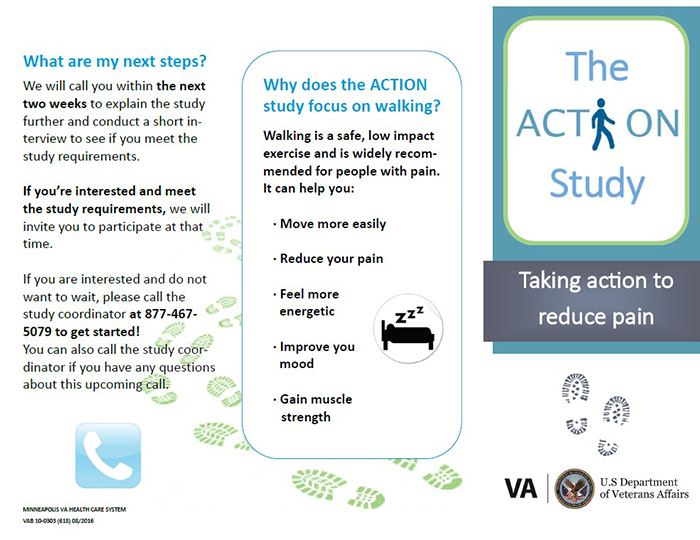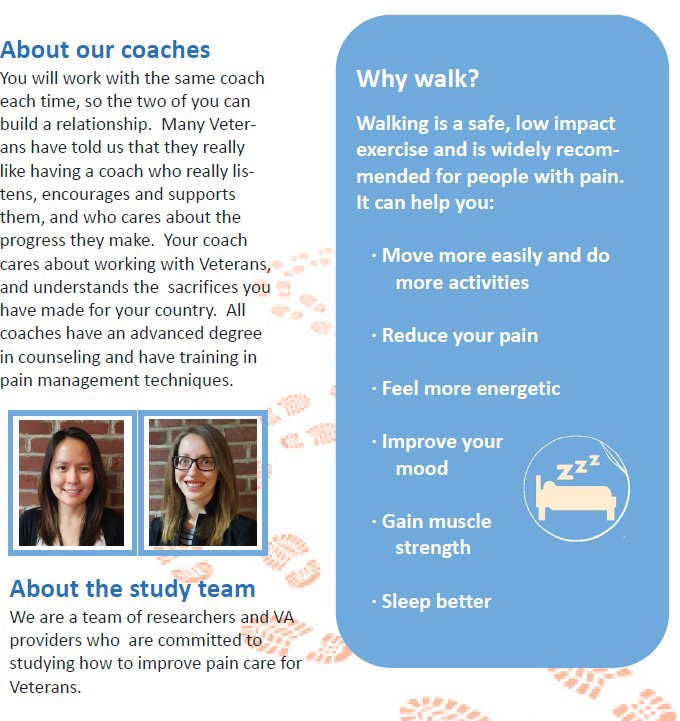 |
Pain Study Benefits from Veteran Engagement in Developing Recruitment Materials for African American VeteransHSR&D’s monthly publication Veterans’ Perspectives highlights research conducted by HSR&D and/or QUERI investigators, showcasing the importance of research for Veterans – and the importance of Veterans for research. In the July 2021 Issue:
|
Introduction
ACTION study principal investigator Diana Burgess, PhD, is a core Investigator at the HSR&D Center for Care Delivery and Outcomes Research (CCDOR) and Co-Director of the VA Advanced Fellowship Program in Health Services Research at the Minneapolis VA Healthcare System.
The “dual crises” of pain and opioids have had a devastating effect on Americans and a disproportionate impact on Veterans. Up to 50% of male Veterans and 78% of female Veterans report pain and Veterans are more likely to experience pain than non-Veterans. Moreover, chronic pain co-exists with mental and physical health conditions that affect many Veterans, such as PTSD, depression, and anxiety. Conventional medical approaches have proved inadequate at addressing pain and, and in the case of opioid-centric treatment, have led to a tremendous increase in deaths, as well as significant increases in opioid abuse and addiction. In response to these crises, the VA-DoD and other healthcare organizations have recommended “multi-modal” treatments that incorporate non-drug and self-management approaches, including exercise. Decades of research show that African Americans in the United States experience more severe and debilitating pain compared to non-Hispanic Whites. African Americans are more likely to have unmet medical needs due to socioeconomic factors including poor quality or no insurance, and experiences of racism within and outside the healthcare system that are associated with avoiding and delaying care. African Americans are more likely to have their pain undertreated, discounted, and underestimated, due in part to provider stereotypes and biases. Furthermore, African Americans experience poorer quality communication with their providers, which can adversely affect the quality of pain treatment. African Americans are also more likely to hold beliefs and engage in coping strategies that contribute to poor pain outcomes, such as lower self-confidence in coping with pain and greater pain-related fear of movement. In addition, racial discrimination is associated with greater pain and factors that contribute to pain, such as poorer mental and physical health, lower levels of physical activity, and living in environments that make exercise more difficult. The ACTION StudyThe objective of the ACTION study was to test whether a telephone-delivered program to promote walking (the ACTION program), aimed at addressing contributors to racial disparities in pain, would improve chronic pain outcomes among African American Veterans. Many studies have shown that walking can reduce chronic pain. ACTION uses two other evidence-based strategies - action planning and motivational interviewing by a coach - to help Veterans meet their walking and exercise goals. In action planning, patients are taught to make a specific plan that specifies where and how the behavior will be performed. Veterans in the ACTION program are also taught to make plans to overcome barriers to walking. Motivational interviewing is a patient-centered approach to behavior change, which can empower participants to overcome barriers to exercise. This program was tailored to African American VA patients through feedback obtained from focus groups. However, investigators also expected that the program would be useful for VA patients from all racial and ethnic groups. 
Veteran EngagementThe ACTION study was extremely successful in recruiting African American Veterans. The study’s goal was to recruit 250 African American participants from a pool of 500 Veterans. The research team was able to recruit 380 African American Veterans suggesting that the engagement of Veterans in the development of recruitment and educational materials was key. Study materials were developed with 2 rounds of feedback from focus groups with African American Veterans with chronic pain at the Atlanta VA healthcare system. The two groups gave initial input on the ACTION materials and raised a lot of issues that study investigators hadn’t previously thought of. Some Veterans voiced their concern about VA’s involvement in this project. They were mistrustful and wanted to know more about who was doing this project and why. Others had numerous questions about the program which were not adequately addressed in the study materials. For example: “How can walking help me with my pain?” “I already know I should exercise – how will this help?” “Will I get a different coach each time?” “Who are these coaches? How are they trained?” “Is this like telemarketing?“ Based on these responses, major revisions were made to recruitment materials. Changes included providing photos and information in the brochure and letter about the research team and why they were doing the research, providing information about the coaches and their training (including photos), and increasing the amount of information about what the program consists of and the research backing it up. The revised versions were sent to 2 more focus groups. 
ImpactAsking the key question - “ Can a walking-focused coaching intervention, aimed at addressing contributors to racial disparities in pain, improve pain outcomes among African American patients with chronic hip, back, or knee pain? “- the ACTION study yielded the following results:
CCDORHSR&D’s Center for Care Delivery and Outcomes Research (CCDOR) develops and evaluates interventions and implementation strategies that improve healthcare delivery, Veteran engagement in healthcare, and Veterans’ health and functioning in their communities. Chronic pain is a major research area for center investigators.The ACTION study shows that a walking-focused telephone coaching intervention may improve pain outcomes for African American Veterans with chronic pain, but those whose life circumstances present significant barriers to walking and also to engaging in 6 telephone coaching sessions may require more resource-intensive programs. Sixty percent of participants had a yearly income of $40,000 or less, 58% had depressive symptoms that met or exceeded the threshold for moderate depression, and 59% used a walking aid. This points to the need for more intensive efforts on behalf of those who have high levels of mental and physical health comorbidities frequently associated with chronic pain, as well as fewer material resources. There were, however, significant improvements in some individuals. One 70-year-old Veteran who was caring for his dying wife in home hospice relayed the following: By helping him identify hurdles/helpers, he had “learned to work around things that get in the way of walking” and had noticed that walking for 30 minutes every day at the park gave him “relief from stress” and that his “pain overall (was) diminished.” He continued: “I haven’t had the need to take any Ibuprofen the last 2 weeks. The reduction in my pain motivated me to continue walking and my stride is getting better.” He appreciated that coaches had come up with different suggestions to get him out to walk because he couldn’t do that before. He had actually exceeded his steps goal by 500 in six out of the previous seven days. Next StepsA major success of the ACTION program was the extremely high enrollment rate of African American Veterans with chronic pain, due to the inclusion of Veterans in the development of recruitment and educational materials. The feedback and revision process provided a more than 75% success rate for recruitment. The study team has presented its recommendations on recruiting patients from under-represented groups to studies on chronic pain to a panel sponsored by the National Institutes of Health’s Helping to End Addiction Long-term (HEAL) initiative. Investigators are also presenting study results to academic and non-academic audiences. They are also using what they learned in ACTION to recruit racially/ethnically diverse chronic pain VA patients for the Learning to Apply Mindfulness to Pain (LAMP) study. |